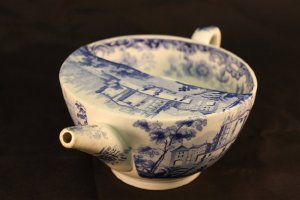Also known as Pap Boats, Invalid Feeders were used throughout the 19th century and well into the 20th century to aid in the feeding of patients that were too weak to feed themselves and in feeding infants. The use of invalid and infant feeders was much more popular in Europe than in the United States. A mixture called Pap, consisting of flour, bread, and water was mixed together to creat a gruel that was fed to the patient. Typically, the feeders were made of ceramic and colorfully decorated, with some shaped like animals for feeding children. Some early Invalid Feeders were made out of sterling silver or clear glass.
The Invalid and Infant Feeder collection at the Edward Hand Medical Heritage Foundation numbers over sixty, and includes examples in clear glass, sterling silver, ceramic, ironstone, and porcelain. The collection dates primarily from the mid to late 19th century.
